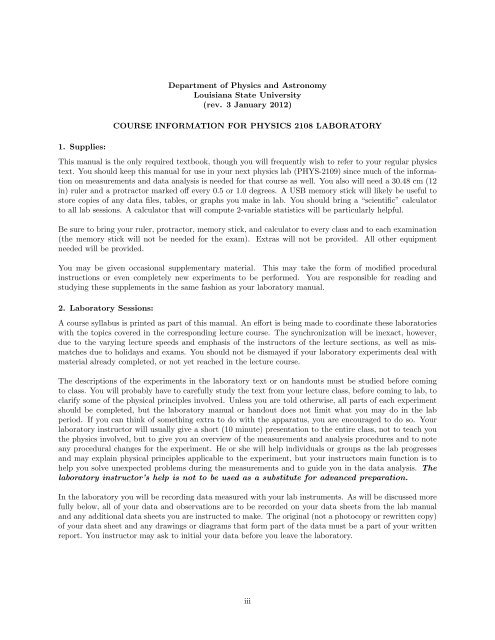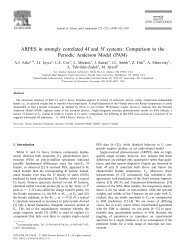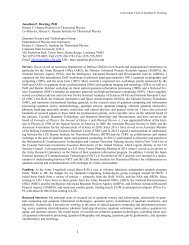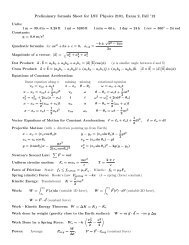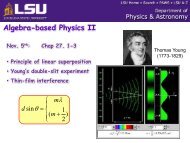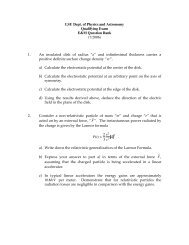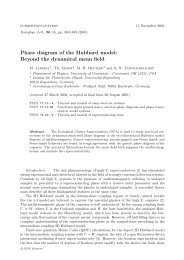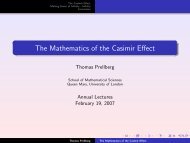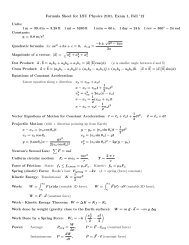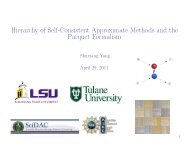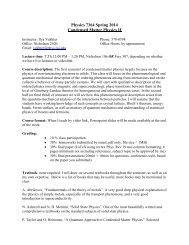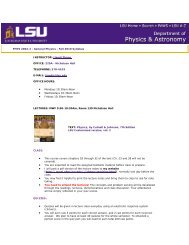Physics 2108 Laboratory Guide - Department of Physics ...
Physics 2108 Laboratory Guide - Department of Physics ...
Physics 2108 Laboratory Guide - Department of Physics ...
Create successful ePaper yourself
Turn your PDF publications into a flip-book with our unique Google optimized e-Paper software.
<strong>Department</strong> <strong>of</strong> <strong>Physics</strong> and AstronomyLouisiana State University(rev. 3 January 2012)COURSE INFORMATION FOR PHYSICS <strong>2108</strong> LABORATORY1. Supplies:This manual is the only required textbook, though you will frequently wish to refer to your regular physicstext. You should keep this manual for use in your next physics lab (PHYS-2109) since much <strong>of</strong> the informationon measurements and data analysis is needed for that course as well. You also will need a 30.48 cm (12in) ruler and a protractor marked <strong>of</strong>f every 0.5 or 1.0 degrees. A USB memory stick will likely be useful tostore copies <strong>of</strong> any data files, tables, or graphs you make in lab. You should bring a “scientific” calculatorto all lab sessions. A calculator that will compute 2-variable statistics will be particularly helpful.Be sure to bring your ruler, protractor, memory stick, and calculator to every class and to each examination(the memory stick will not be needed for the exam). Extras will not be provided. All other equipmentneeded will be provided.You may be given occasional supplementary material. This may take the form <strong>of</strong> modified proceduralinstructions or even completely new experiments to be performed. You are responsible for reading andstudying these supplements in the same fashion as your laboratory manual.2. <strong>Laboratory</strong> Sessions:A course syllabus is printed as part <strong>of</strong> this manual. An effort is being made to coordinate these laboratorieswith the topics covered in the corresponding lecture course. The synchronization will be inexact, however,due to the varying lecture speeds and emphasis <strong>of</strong> the instructors <strong>of</strong> the lecture sections, as well as mismatchesdue to holidays and exams. You should not be dismayed if your laboratory experiments deal withmaterial already completed, or not yet reached in the lecture course.The descriptions <strong>of</strong> the experiments in the laboratory text or on handouts must be studied before comingto class. You will probably have to carefully study the text from your lecture class, before coming to lab, toclarify some <strong>of</strong> the physical principles involved. Unless you are told otherwise, all parts <strong>of</strong> each experimentshould be completed, but the laboratory manual or handout does not limit what you may do in the labperiod. If you can think <strong>of</strong> something extra to do with the apparatus, you are encouraged to do so. Yourlaboratory instructor will usually give a short (10 minute) presentation to the entire class, not to teach youthe physics involved, but to give you an overview <strong>of</strong> the measurements and analysis procedures and to noteany procedural changes for the experiment. He or she will help individuals or groups as the lab progressesand may explain physical principles applicable to the experiment, but your instructors main function is tohelp you solve unexpected problems during the measurements and to guide you in the data analysis. Thelaboratory instructor’s help is not to be used as a substitute for advanced preparation.In the laboratory you will be recording data measured with your lab instruments. As will be discussed morefully below, all <strong>of</strong> your data and observations are to be recorded on your data sheets from the lab manualand any additional data sheets you are instructed to make. The original (not a photocopy or rewritten copy)<strong>of</strong> your data sheet and any drawings or diagrams that form part <strong>of</strong> the data must be a part <strong>of</strong> your writtenreport. You instructor may ask to initial your data before you leave the laboratory.iii


